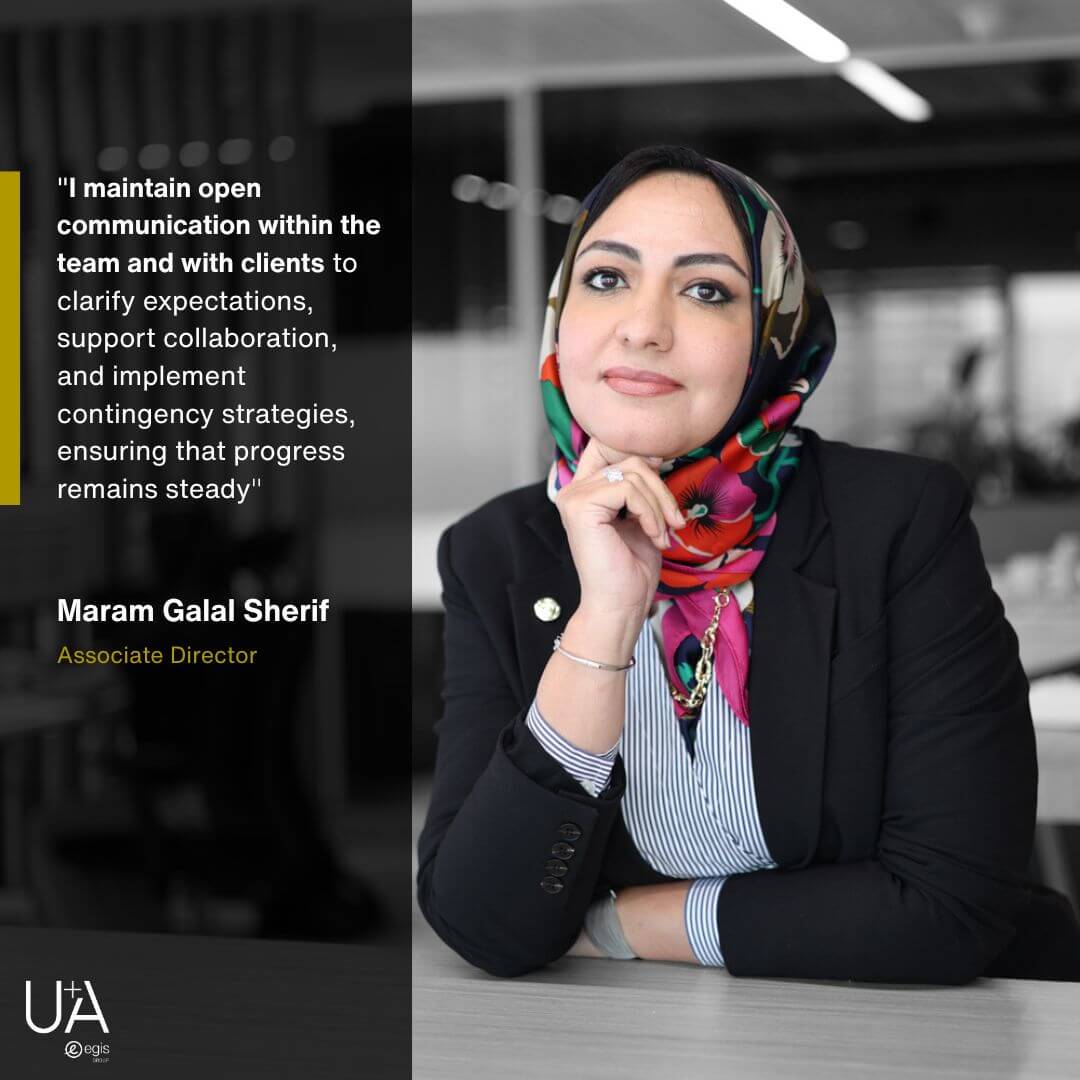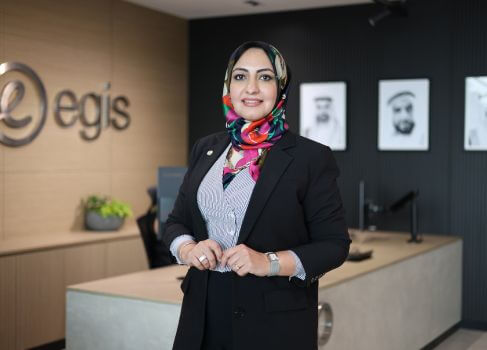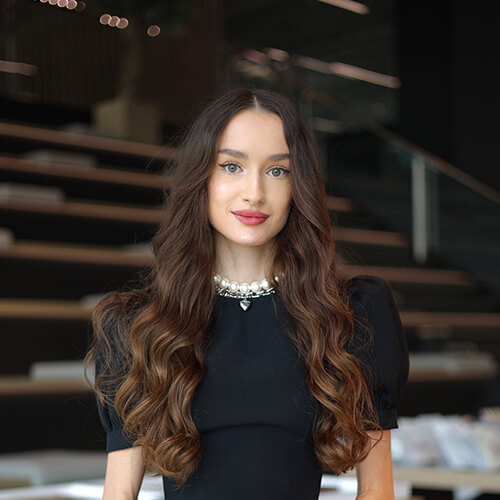.jpg?v=8d38a935a422ec39486e2ff74c742e3e)
Maram Galal: Building Futures, Managing Chaos, and Finding Calm in Complexity

Maram Galal: Building Futures, Managing Chaos, and Finding Calm in Complexity
Maram Galal Sherif, Associate Director at U+A, brings over two decades of architectural mastery to every blueprint. With 18 years in the UAE and a background in both architecture and business, she navigates large-scale projects with precision and empathy. From Master plan communities to Complex developments & Skyscrapers across the Gulf, Maram blends visionary thinking with technical command, grounding her designs in practicality and her leadership in trust. A strategic powerhouse with a creative soul, she continues to shape skylines and inspire teams with grace under pressure.
What moment in your career tested you the most, and how did you push through?
The most demanding phases of my career have been major turning points: entering architecture school, transitioning into my first consultancy role, and moving from concept design to architectural development. Each stage required quickly assimilating new technical knowledge, adjusting to various professional environments, and maintaining motivation through steep learning curves. I overcame these moments by taking initiative in my learning, seeking guidance from colleagues and mentors, and staying persistent in overcoming each new challenge.
When a project starts slipping into chaos and tight deadlines, moving parts, stressed teams- what’s your personal system for regaining control?
When a project threatens to lose direction due to multiple pressures, I respond by reevaluating deliverables, establishing clear and realistic priorities based on current timelines and resources, and reorganizing the workflow. I maintain open communication within the team and with clients to clarify expectations, support collaboration, and implement contingency strategies, ensuring that progress remains steady and quality is maintained.
Architecture can be overwhelming. What’s one daily habit that keeps you grounded, and one that’s just for joy?
A daily habit that keeps me grounded is practicing honest self-reflection and maintaining a healthy sleep routine. For balance and enjoyment, I dedicate time each day to wellness activities such as visiting a spa, engaging with art, or networking with peers. These habits support my professional focus while fostering well-being and creativity.
What’s one common mistake senior architects make under pressure?
A common misstep is neglecting to implement precise submission schedules and milestones for project phases. Without this structure, it is easy for teams to fall behind or overlook critical tasks, leading to unnecessary stress and reduced efficiency.
You manage large teams with diverse backgrounds. What’s one leadership trait you think more architects need to develop?
One of the most important leadership traits for architects managing large, diverse teams is true ownership of problems through to resolution. Demonstrating ownership means taking full responsibility for both challenges and outcomes, rather than attributing issues to external factors or simply delegating without follow-through. This quality builds trust and credibility within a team. When a leader is visibly accountable, team members feel empowered to take responsibility for their own work and decisions as well.
Ownership also promotes a culture of accountability throughout the project and the wider organization. In a diverse team, this approach helps unify individuals around shared goals, encourages proactive problem-solving, and minimizes finger-pointing or miscommunication. By modeling this standard, architects foster an environment where everyone collaborates more effectively, contributes ideas openly, and commits to seeing tasks through, which is vital for delivering complex architectural projects successfully
What’s the most surprising lesson architecture has taught you, not about buildings, but about people?
One of the most surprising lessons architecture has taught me about people is the value of creative problem-solving. Successful projects demand not only technical expertise but an ability to navigate differing perspectives, adapt to changing needs, and find innovative solutions, qualities that are just as relevant in interpersonal relationships as they are in design. Ultimately, the practice has shown that empathy, flexibility, and collaboration are essential for building both resilient structures and strong professional connections.
When you reflect on a finished project, what detail tells you it was truly a success, even if no one else notices it?
When reflecting on a completed project, true success is often evident in those core design details that remain fully intact from initial concept to final execution. The ability to carry these original elements through every stage, despite evolving requirements or external pressures, shows both the strength of the design vision and the effectiveness of the project management process. Even if unnoticed by others, seeing these unaltered aspects affirms that the initial intent was well-founded and resilient enough to endure practical constraints.

Receive articles like this
Related roles
Salary
-
Location
Dubai
Experience level
Associate
Location
Dubai
Job Family
Architecture
Type of Contract
Permanent Contract
Brands
U+A
Description
Develop and manage BIM models for interior design and architecture, collaborate with architects, engineers and other project stakeholders.Ensure model accuracy and compliance with industry standards a
Reference
7eedc3fb-5bd4-49ac-8215-dc40a1a1e159
Expiry Date
01/01/0001

Author
Lisa Smith
Author
Lisa SmithSalary
-
Location
Abu Dhabi
Experience level
Mid-Senior Level
Location
Abu Dhabi
Job Family
Health, Safety and Security
Type of Contract
Permanent Contract
Brands
U+A
Description
We are seeking a highly skilled and experienced HSE Engineer to join our site team in Abu Dhabi.Key Responsibilities: Ensure the Contractors implement and follow the approved HSE Plan and various proc
Reference
0c8e666a-cfcc-4253-a7de-f1ec5ce95cb9
Expiry Date
01/01/0001

Author
Lisa Smith
Author
Lisa SmithSalary
-
Location
Dubai
Experience level
Mid-Senior Level
Location
Dubai
Job Family
Site Supervision
Type of Contract
Permanent Contract
Brands
U+A
Description
We are seeking a competent and detail-oriented Structural Inspector to join our supervision team in Dubai. The role involves ensuring that all structural works on site are executed strictly in accorda
Reference
b0c1ed62-4cb8-4434-8b4b-71991076a41b
Expiry Date
01/01/0001

Author
Lisa Smith
Author
Lisa SmithSalary
-
Location
Dubai
Experience level
Mid-Senior Level
Location
Dubai
Job Family
Architecture
Type of Contract
Permanent Contract
Brands
U+A
Description
We are seeking a highly skilled and detail-oriented Structural Inspector to join our site team in Dubai. In this critical role, you will be responsible for ensuring the structural integrity and safet
Reference
45c82ab8-067e-4a54-8834-b266630afc8c
Expiry Date
01/01/0001

Author
Lisa Smith
Author
Lisa SmithSalary
-
Location
Dubai
Experience level
Mid-Senior Level
Location
Dubai
Job Family
Architecture
Type of Contract
Permanent Contract
Brands
U+A
Description
Conduct site inspections prior to the commencement of construction activities to ensure site conditions align with the design of permanent works. Identify and document any obstructions or issues.Photo
Reference
d71c4a1c-6846-4067-9ac0-f005c0c051d8
Expiry Date
01/01/0001

Author
Lisa Smith
Author
Lisa SmithSalary
-
Location
Abu Dhabi
Experience level
Mid-Senior Level
Location
Abu Dhabi
Job Family
Architecture
Type of Contract
Permanent Contract
Brands
U+A
Description
We are seeking a highly skilled Senior Mechanical Engineer to join our team in Abu Dhabi. In this critical on-site role, you will lead mechanical engineering projects and team, oversee installations,
Reference
25a44503-df93-4299-a10a-8a0fd4510b8f
Expiry Date
01/01/0001

Author
Lisa Smith
Author
Lisa SmithSalary
-
Location
Dubai
Experience level
Mid-Senior Level
Location
Dubai
Job Family
Architecture
Type of Contract
Permanent Contract
Brands
U+A
Description
The Architect Site role is a critical position responsible for ensuring the highest standards of architectural integrity and project compliance. The successful candidate will be entrusted with the fol
Reference
3305da72-8da2-4238-bf35-e8a1bfe99b4a
Expiry Date
01/01/0001

Author
Lisa Smith
Author
Lisa SmithSalary
-
Location
Dubai
Experience level
Mid-Senior Level
Location
Dubai
Job Family
Architecture
Type of Contract
Permanent Contract
Brands
U+A
Description
Responsibilities:Conduct thorough inspections of architectural elements, including walls, drywall, doors, windows, and other finishes to ensure compliance with building codes, standards, and project s
Reference
830f08bc-d159-48b6-92a9-dbc05d238270
Expiry Date
01/01/0001

Author
Lisa Smith
Author
Lisa SmithSalary
-
Location
Dubai
Experience level
Mid-Senior Level
Location
Dubai
Job Family
Site Supervision
Type of Contract
Permanent Contract
Brands
U+A
Description
We are seeking a highly skilled and experienced Resident Engineer to join our team in Dubai, United Arab Emirates. As a key member of our construction management team, you will be responsible for over
Reference
7518b487-9beb-4229-88bf-0ec1fe8a7e8e
Expiry Date
01/01/0001

Author
Lisa Smith
Author
Lisa SmithSalary
-
Location
Abu Dhabi
Experience level
Mid-Senior Level
Location
Abu Dhabi
Job Family
Architecture
Type of Contract
Permanent Contract
Brands
U+A
Description
We are seeking a highly skilled and experienced Senior Resident Engineer to join our team in Abu Dhabi. As a key member of our building construction management team, you will be responsible for overse
Reference
7517dcfd-7b2d-40af-be96-fcc84836bce8
Expiry Date
01/01/0001

Author
Lisa Smith
Author
Lisa SmithRelated Articles

Teaser
ArticleContent Type
TestimoniesPublish date
10/07/2025
Summary
Architecture That Connects: Crafting Experiences Beyond Form Designing architecture for experience relies on creating spaces centered on human needs. Sensory e

by
Sofia Filipchenkova
Your perfect role awaits at Egis: backed by expertise, driven by passion!
With decades of industry expertise, Egis is dedicated to helping you find your ideal role.
Whether you're an experienced professional or new to the field, our team is here to support your journey, providing guidance every step of the way.
Discover opportunities that match your passion and skills with Egis.
Recently viewed jobs




